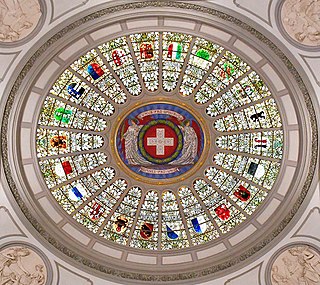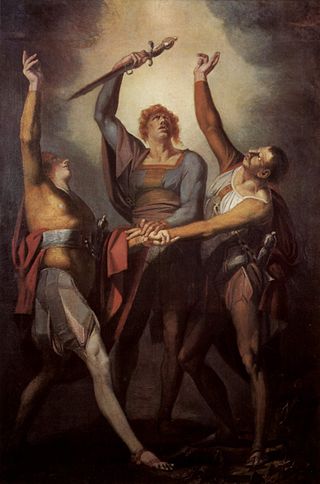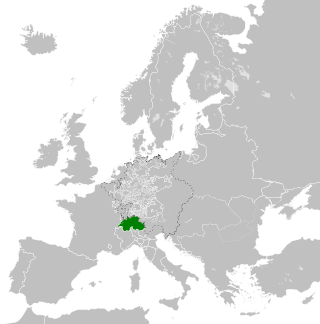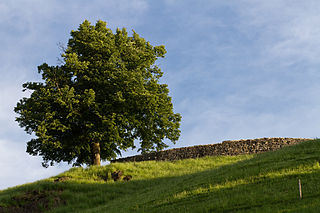
Stans is the capital of the canton of Nidwalden (Nidwald) in Switzerland.

Obwalden or Obwald is one of the 26 cantons forming the Swiss Confederation. It is composed of seven municipalities and the seat of the government and parliament is in Sarnen. It is traditionally considered a "half-canton", the other half being Nidwalden.

Nidwalden or Nidwald is one of the 26 cantons forming the Swiss Confederation. It is composed of eleven municipalities and the seat of the government and parliament is in Stans. It is traditionally considered a "half-canton", the other half being Obwalden.

The Battle of Sempach was fought on 9 July 1386, between Leopold III, Duke of Austria and the Old Swiss Confederacy. The battle was a decisive Swiss victory in which Duke Leopold and numerous Austrian nobles died. The victory helped turn the loosely allied Swiss Confederation into a more unified nation and is seen as a turning point in the growth of Switzerland.

Each of the 26 modern cantons of Switzerland has an official flag and a coat of arms. The history of development of these designs spans the 13th to the 20th centuries.

The Old Swiss Confederacy began as a late medieval alliance between the communities of the valleys in the Central Alps, at the time part of the Holy Roman Empire, to facilitate the management of common interests such as free trade and to ensure the peace along the important trade routes through the mountains. The Hohenstaufen emperors had granted these valleys reichsfrei status in the early 13th century. As reichsfrei regions, the cantons of Uri, Schwyz, and Unterwalden were under the direct authority of the emperor without any intermediate liege lords and thus were largely autonomous.

Arnold von Winkelried or Arnold Winkelried was a legendary hero of Swiss history. According to 16th-century Swiss historiography, Winkelried's sacrifice brought about the victory of the Old Swiss Confederacy in the Battle of Sempach (1386) over the army of the Habsburg Duke Leopold III of Austria.

Sempach is a municipality in the district of Sursee in the canton of Lucerne in Switzerland.

Georg von Frundsberg was a German military and Landsknecht leader in the service of the Holy Roman Empire and Imperial House of Habsburg. An early modern proponent of infantry tactics, he established his reputation in active service during the Italian Wars under Emperor Maximilian I and his successor Charles V. Even in his lifetime, he was referred to as "Vater der Landsknechte" and legends about him as the patriarchal figure of the Landsknechte or his incredible physical strength surfaced.

The Battle of Bicocca or La Bicocca was fought on 27 April 1522, during the Italian War of 1521–26. A combined French and Venetian force under Odet de Foix, Vicomte de Lautrec, was decisively defeated by an Imperial–Spanish and Papal army under the overall command of Prospero Colonna. Lautrec then withdrew from Lombardy, leaving the Duchy of Milan in Imperial hands.

The Rütli Oath is the legendary oath taken at the foundation of the Old Swiss Confederacy by the representatives of the three founding cantons, Uri, Schwyz and Unterwalden, It is named after the site of the oath taking, the Rütli, a meadow above Lake Uri near Seelisberg. Recorded in Swiss historiography from the 15th century, the oath is notably featured in the 19th century play William Tell by Friedrich Schiller.
There are at least five historical people of Unterwalden called Arnold Winkelried.

The Old Swiss Confederacy, also known as Switzerland or the Swiss Confederacy, was a loose confederation of independent small states, initially within the Holy Roman Empire. It is the precursor of the modern state of Switzerland.
Sempacherlied is the title of a number of patriotic songs celebrating the Swiss victory at the Battle of Sempach (1386).

Heinrich von Winkelried, known as Schrutan or Strut "the giant", was a medieval knight in what is now Central Switzerland.
Hermann von Liebenau was a Swiss historian.
Mueterschwanderberg is a ridge forming the southern shore of Alpnachersee, just northwest of Stanserhorn and west of the village of Ennetmoos, Nidwalden, Switzerland. Its peak is at an elevation of 860 m. The peak is known as Drachenflue (Drachenfluh), with the Drachenloch cave nearby, named for the dragon which according to legend was slain here by Heinrich von Winkelried.

Petermann of Gundoldingen was Schultheiss of Lucerne and participated in the Battle of Sempach.

Rotzberg or Rotzburg is a ruined castle in the municipality of Ennetmoos in the canton of Nidwalden in Switzerland.

The Winkelried memorial was erected in memory of Arnold von Winkelried, who sacrificed his life in the Battle of Sempach on the 9 July 1386. According to the Swiss historiography, the Swiss wouldn't be able to break through the firmly positioned order of Habsburg pikemen. At a moment, Winkelried decided to throw himself into the pikes and therefore open a passage through the Austrian defensive front, which made way for an attack of the Swiss confederacy which then led to a Swiss victory in the Battle of Sempach.
















